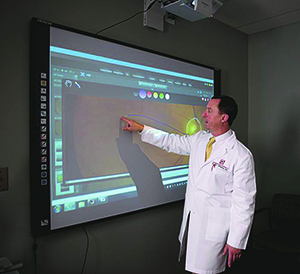Various companies make these systems. At our practice, Southeastern Retina Associates in eastern Tennessee, these boards are becoming an important tool for teaching our patients about their specific diseases and conditions. Richard Breazeale, MD, is the first of our group’s 14 physicians to use the board in one of our 19 locations.
As he begins to explain retinal images to patients, he can bring up images from previous visits by touching icons for optical coherence tomography, fluorescein angiography and fundus photography icons. By dragging the previous images beside the current image, he can easily show changes to the patient. He can expand on his explanation by drawing or writing on the board during his discussion with the patient.
Big Enough to See
Interactive boards enable patients to see their own eyes in ways that simply haven’t been possible before. Often patients come to us with problems and we are unable to explain what is going on with their vision. They frequently have compromised vision, so they can’t clearly see their charts or diagnostic photos displayed on our computer screens.
Smart Board
Our practice is currently using the boards in beta testing. Interactive white boards are expensive but effective. Our doctors and staff can explain to patients their diagnosis using their own pictures. Patients who are contemplating surgeries can also watch a video so they know what to expect. Our doctors have shown patients diagrams of what they want their treatment to accomplish.
Engaging Patients
Interactive white boards have also had an unexpected benefit: They have enhanced communication between patient and physician. Once doctors know the diagnosis, their first task is educating the patient.Traditionally, when a doctor walks into the room, a scribe is present to enter the exam data into a computer, but Dr. Breazeale says sharing that information with patients has always been challenging. The white board brings patients into the conversation in a way that actively involves them.
The response of our patients to the interactive boards has been overwhelmingly positive. Every patient we have asked has told us they like the exam rooms furnished with the boards better than the other exam rooms.
Insurance Review Repellent
As injections for age-related macular degeneration and diabetic macular edema have increased, so have insurance company reviews. We’ve used white-board technology to educate medical directors of two national insurance plans, and both said the presentation helped them to better understand our retina specialists’ decision-making process before initiating anti-VEGF treatment.Dr. Breazeale believes the use of this technology will increase once doctors realize its usefulness as a teaching tool. Interactive boards are used in schools, so we’ve brought something from the classroom into the clinical setting. RS
Ms. Brock is practice liaison director and compliance officer for Southeastern Retina Associates PC, in eastern Tennessee.



